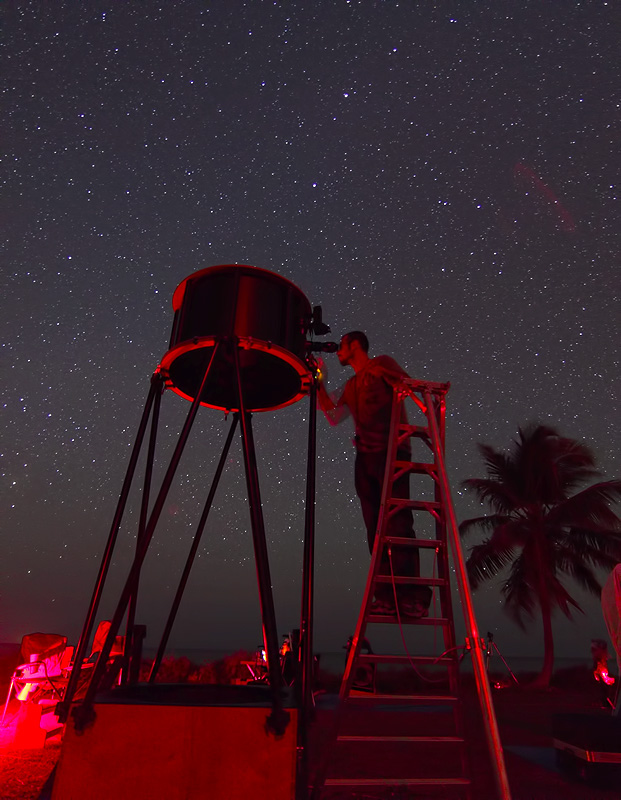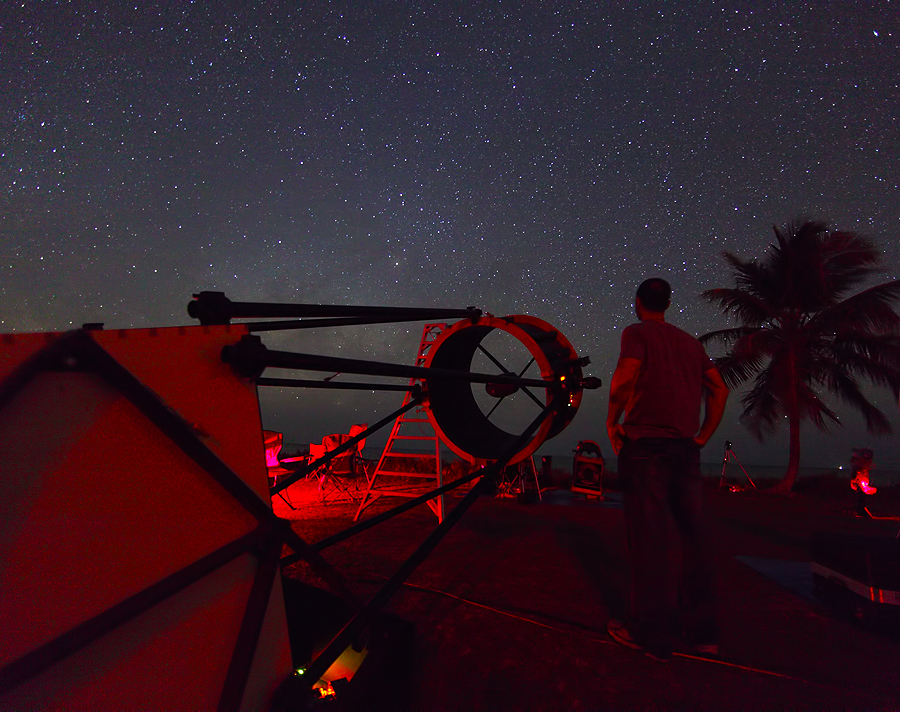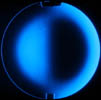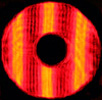March 7,
2011: A
Client's Story, Part 2 - Resolution
You may remember an "In
the Shop" entry from last year regarding a 32" mirror and 6"
minor axis flat that I tested.
I
am happy to report that the owner has reassembled his telescope
following the refigure and recoating of both mirrors, and has tested
the telescope both at his home and at the Winter Star Party.
To
try to quantify things a bit, using my Foucault zonal measurements,
before the
refiguring the mirror had a (best case) peak-to-valley wavefront error
of about 0.9 waves. After the rework,
the peak-to-valley wavefront error was indicated below 0.1 waves
according to the tests. This mirror is smooth and is a
good figure of revolution, so the estimated wavefront errors are very
close to what should be measured across any axis.
The flat was improved from ~1/2 wave to ~1/8th wave.
Not
convinced by the numbers? Based only on his experiences at
home,
he wrote this short report which should help to remove any doubt.
"I
had a chance the other night to make some initial observations with the
32" 'premium' mirror and accompanying 6" flat that you refigured for
me. I only had a few hours before the rising of the waning
gibbous moon to observe a few objects.
 I
am absolutely STUNNED
by the visual improvement over the old optical performance of the
scope. I had expected quite a difference, but I guardedly
didn't
expect this magnitude of improvement.
I
am absolutely STUNNED
by the visual improvement over the old optical performance of the
scope. I had expected quite a difference, but I guardedly
didn't
expect this magnitude of improvement.
All traces of the severe
undercorrection of the primary mirror have been eliminated in the star
test, and all aspects of visual observation are greatly improved.
There is so much more detail to see in all objects:
- When
observing M-42, I was shocked at the improved crispness/sharpness
across the entire field of view. The background sky is much
darker,
the star diameters much smaller, nebular detail is much
improved with
amazing
vivid color intensity. The myriad of tiny pinpoint stars in
the gaseous area surrounding the trapezium, blinking in and
out with
the seeing changes, are astounding.
- Planetary
nebula such as the eskimo do not disappoint, as the central star was
not bloated, and increased intricate detail was be observed in the
outer gaseous rings of the nebula.
- Sirius
B was easily visible from 40 degrees N latitude and gave a good
indication of the seeing which appeared to be around 3 arc
seconds (3-3+/5 fast moving upper level turbulence) based on the number
of star diameters that would fit between Sirius A/B.
I
realize these are not 'challenge objects', but these are the objects
that I can compare and contrast to a higher accuracy based on
observational experience.
Before
refigure, I found myself struggling to find an exact focus point due to
the large area of longitudinal aberration caused by the
undercorrection. 'Best focus' was obscured by scattered light
from the correction error.
The focus is now so sensitive that I
find myself wanting a high gear reduction focuser greater than
10:1. Focus suddenly and definitively snaps,
impressive.
The initial views through these optics are every bit as sharp as my
smaller excellent 12.5" scope. Finally, no compromise at
larger
aperture.
What amazes me the most, is that these observations
were made under average at best seeing conditions. The views
on
this 'average' night far outperformed any night at any location, star
party, etc.. that I have been to with this scope. It is a
stark
reminder of how much the optics, not the seeing or other variables,
were limiting the views.
I look forward to no longer having to
spend my nights blaming seeing or some other variable/excuse for the
poor performance of these optics. Thank you so much for
saving me
from sliding into the depths of SALAD (spherically aberrated large
aperture denial)!
I would like to say to other large aperture
owners out there, if you are not pleased with your 'premium' large
aperture optics performance and are tired of eliminating thermals,
seeing, collimation, and structural support, and making nightly excuses
for the performance of your "premium" optics - there is a remedy!
Thank you for figuring/refiguring large aperture optics that perform
without compromise or excuses."
That pretty much
says it all.
I
had the opportunity to use the 32" telescope at
the Winter Star Party last week. Monday night was clear and
reasonably steady. I uncovered my own 20" f/3, collimated it,
and
headed for the 32". As it ended up, I did not use my 20" f/3
for that whole
night! I was having too much fun "borrowing" photons from the
32", and the views were some of the best I have ever seen through an
eyepiece.
Above is one of
my photos of the owner enjoying a view on this evening.
I'll never forget this night of viewing, because it was the
first
time I have ever seen such a large instrument perform like it truly
should thanks to a combination of good optics, proper collimation, and
steady, fairly dark skies.
Highlights
were a stunning Saturn early Tuesday morning, showing more color and
contrast than in any instrument I have ever seen, many faint moons, the
Encke minimum, and spokes/structure in the rings!
Early Tuesday night I
saw ten stars in the Trapezium in M42, and previously I had not ever
seen more than six. I think more would have been visible if
the
wind had not been shaking the telescope.
On Thursday night, the
Eskimo had a mouth at 1400x, despite strong winds and seeing that was
not as good as is possible in the Florida Keys.
Here are some more of his words:
"What
a conclusion to the story! Having this scope with it's now superb refigured
optics, thanks to Mike, has re-energized my passion to observe. It is providing
views with more clarity and detail than I could have imagined and has so
far met and exceeded my expectations.
Some
of the observations made with this scope from the WSP will forever be imprinted
in my mind. Looking at the trapezium Tuesday evening and seeing G, splitting
the H star(at 1.6" separation), and seeing fleeting but definitive glimpses
of the I star for a total of 10 stars in the trapezium, was awesome. Considering
these are 15-16 magnitude stars(depending on what information source
is
cited) surrounded by four bright stars and a beautiful nebula, this is
quite an
exciting observation. Just imagine, it required the 36" lick refractor
to be built
before the G star and H double were discovered by Barnard.
The
Owl nebula was a very fine observation with the dark "eyes" staring back
at me unfiltered. The central star, and others, easily visible with
direct vision.
The
Eskimo Nebula at 1380x showed amazing structure of the inner gas ring including
the oval loop(mouth) feature that I have only seen in photographs. The
outer wide ring presented faint, intricate lateral striations. Why stop
at 1380x?
That was the limit of my eyepiece collection!
The
view of Saturn around 2 or 3 AM on Tuesday morning was the absolute highlight
of the whole week for me. I could have packed up the telescope Tuesday
and left satisfied. The wind calmed enough to take advantage of razor sharp
views of the planet. The planet was crisp with multiple tiny moons skirting
the rings. The vividness of the creamy brown,yellow, white and gold colors
of the gas bands on planet was something I have never experienced
before. The
cloud bands on the globe were well defined. The ring detail was
absolutely jaw
dropping as the Cassini and Encke division were both easily visible.
I have
never seen the Crepe(C) ring so well. It had a very dark brown/ruddy
color and
appeared to have a coarse texture. Lateral color variations(spokes),
light and
dark yellow/brown were noticeable in the outer portions of the rings themselves.
My description cannot do the experience justice. What a sight!!
Many
other nebula, globulars, clusters, galaxies, and planetaries were observed.
Each with intricate details to be seen with newborn sharpness, crispness,
and color present.
I
couldn't be happier with the visual results after the refigure. I
had a wonderful WSP despite the wind. I felt fortunate to have the
opportunity
to observe/compare the same objects through superb 20", 25", and 32" instruments
and see the true resolution/detail advantage that quality large aperture
provides. I'm looking forward to my next observng session.
Great
work Mike!!"
The
moral of the story is - with good optics, aperture rules. It
delivers more light, greater resolving power, and greater perceived
contrast due to the extra light.
I hope this example gets more
observers interested in serious aperture. There are a lot of
bad,
large instruments out there that give the good ones a bad name.
I
believe that, right now, there are far more bad instruments than good
ones. However, once you see a good one your whole
perspective changes. I hope to improve them, one by one, and
show
people what they are truly capable of.
Finally,
I thought I'd end with a rather symbolic photo - the owner starting at
the rising summer Milky Way on a warm night in the Keys.
Scorpius
is tempting the observers, rising just over the truss poles and
observing ladder, climbing out of the wind-swept Gulf.

As
the year goes on,
he will get to explore this region of the sky, densely populated with
beautiful and interesting objects.
Should keep him busy for a while!
Please check back for future installements of "In
the Shop".
Mike
Lockwood
Lockwood Custom Optics




 I
am absolutely STUNNED
by the visual improvement over the old optical performance of the
scope. I had expected quite a difference, but I guardedly
didn't
expect this magnitude of improvement.
I
am absolutely STUNNED
by the visual improvement over the old optical performance of the
scope. I had expected quite a difference, but I guardedly
didn't
expect this magnitude of improvement.